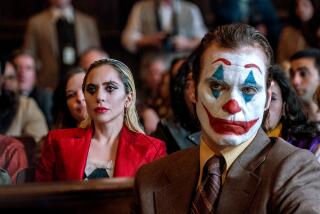‘The Lego Movie’: Six lessons from its box office success
When I saw “The Lego Movie” about six weeks ago — alone, in a screening room, with no social proof of any kind — I had two thoughts. The first: Am I crazy, or is this pretty great? The second: Will a mainstream audience go for it?
That latter question of course yielded a big yes last weekend, with the film pulling in $69.1 million, one of the largest-ever openings for a movie this time of year.
Extracting lessons from a film that is sui generis in so many ways doesn’t really make sense — the reason it worked is precisely because it wasn’t like anything else. Then again, there are some things the Phil Lord-Chris Miller film did — and didn’t — do that helped make it better than the average (minifigure) bear. A breakdown:
PHOTOS: Winter movie sneaks 2014
About a toy. The comparisons made by many in the blogocracy — this space included — is to “Transformers” and “G.I. Joe,” two successful movie franchises based on toys. But those films were far less lauded, in part because many of us could sense what they really were: big action movies with a tie-in slapped on to make marketing the film easier. “Lego” may have been greenlighted in part because it had a name people knew. But the toy wasn’t just an excuse for a film: its essence was also part and parcel of the movie, from its look to its themes (e.g., the legitimate tension between freedom and conformity).
Changes in latitude. It seems self-evident: Let creative people run the show and keep corporate interests out of the edit room as long as possible. Of course, when hundreds of millions of dollars are involved, good luck getting that lock to work. Still, “Lego” — perhaps because of the originating company’s Danish roots, perhaps because Lord and Miller, as well as producer Dan Lin, were coming off hits and had a fair amount of clout — was made with a comparatively small amount of interference. “Lego,” for instance, didn’t have full script approval.
Brand love. Take a character people really have love for, not just remember, and make a movie about that. (See also under: “The Lorax,” a movie not nearly as good but that just came with a lot of fond associations.) Also, it doesn’t hurt to add some freewheeling aspects — create a sense of unpredictability and discovery that people associate with those brands. Much of the fun of “The Lego Movie” is thinking, “Wow, did they just try to get away with that?”
PHOTOS: Box office top 10 of 2013
Adult content. The real kind, not an occasional aside. I grew up in the age of Pee-Wee Herman (stay with me here), the gold standard in camouflaging adult jokes with the kiddie stuff. “Lego” did the same thing. That meta ending — which Lord and Miller pushed forward despite Warner’s concerns — made sure those of us well beyond grade school would smile a subversive smile (and maybe recall “St. Elsewhere” and “Newhart” finales to boot). There’s a reason 59% of this movie’s opening-weekend audience was 18 or older — nine points, incidentally, higher than “Frozen.”
Acknowledge the elephant. Or, mock yourself and no one will mock you. Most movies with branded characters galore play it with a straight face, making us roll our eyes. But “Lego” constantly poked fun at these elements even as it threw them at us: “Batman” playing against type as a jerk, shots of Lego sets that were actually failed lines, and, of course, the song. Oh, that song. It’s much easier to hum along to something as shamelessly sugary as “Everything is Awesome” if we know that the filmmakers want us in on the shamelessness. Or as Miller said: “We want to point out how plastic pop music can be, but we also wanted to note how we all love to listen to it sometimes anyway.”
Happy accidents. It’s striking how often good movies happen because something in the system didn’t operate as it usually does. “The Godfather” and many of its ‘70s ilk because the studios were in disarray, or “Hangover” because Todd Phillips made an unusual deal with Warner Bros. when the studio was less than convinced. “Lego” didn’t follow some of the usual animation development patterns — not least because its toy partner was a Hollywood newbie and because its studio rarely makes animated films — and that created a different kind of kismet. The best movies come out of someone not trying really hard to make the best movie.
ALSO:
‘The Lego Movie: Building a postmodern toy film
‘Lego’ tops box office with $69.1 million
‘The Lego Movie’ begins to put together a hit weekend
Follow me on Twitter @ZeitchikLAT
More to Read
Only good movies
Get the Indie Focus newsletter, Mark Olsen's weekly guide to the world of cinema.
You may occasionally receive promotional content from the Los Angeles Times.









